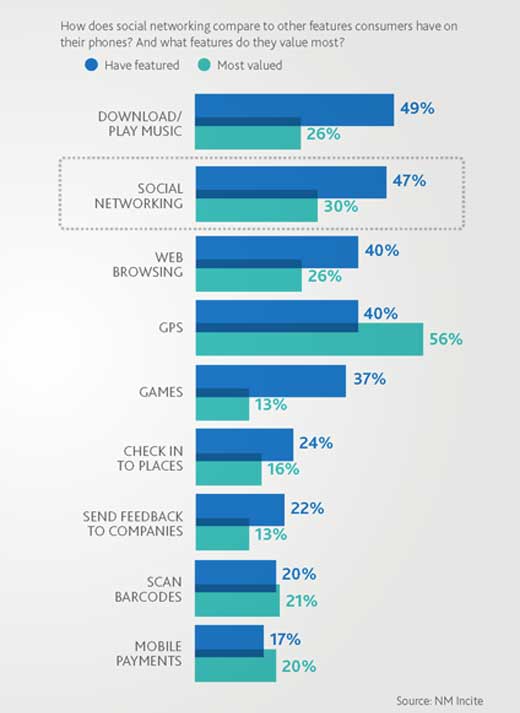With the iPhone4S to be released tomorrow for millions of Americans…we cannot wait to tap into this new device. As we look through the specs of this new, faster mobile device…we see that has the HSDPA technology built in stating that it can leverage up to 14.4Mbps download speeds. Now, there are many that have tested this feature in large, metro areas stating that these speeds in reality are not half this speed. But there are Android phones like the Droid Bionic that are tapping into the Verizon 4G LTE network with faster download speeds.
Yes…our mobile devices can access the network faster and faster and faster. Reading through the OnQ blog by Qualcomm as they address this explosion of social media technologies:
“With all this expansion, one lingering question on everybody’s mind is ‘will the wireless networks be able to keep up with this growth?’ The obvious answer is a resounding YES. As I have explained in these blogs, 3G/4G networks are well equipped now, and evolving in the future, to address the massive increase in the sheer volume of data growth.”
Nielsen release their 3rd Quarter 2011 Social Media Report with some interesting stats on mobile device usage: “The ability to access social media is a commonly used feature among mobile owners. According to a recent study by NM Incite, a Nielsen/McKinsey Company, nearly 2 in 5 social media users access these services from their mobile phones.”
Here is how social media access ranks against other features offered on their mobile devices (from Nielsen’s 3rd Quarter 2011 Social Media Report):
The above statistics suggest we are access social media outlets on our mobile devices more than access the web. WOW!
In Steven Van Belleghem presentation “Social Media Around the World” on slide 140 states, “56% of smart phone users follow a brand on social media.”
What does all this mean…people are accessing information via smart phones. People are heavily using social media outlets on their smart phones, creating data transfer which demands more bandwidth. The more the usage, the more the demand. This demand is fueling the growth of the mobile network. You think you see a lot of advertisements between the major carriers talking about 4G, 4G LTE, unlimited data, throttling…you need to start researching this information. We are data transfer hogs and connecting to others via our smart phones. This is fueling the growth in our networks, which is leading to large investments in the mobile infrastructure and mobile gadgets like iPhones and Droids.
Prakash Sangam, Senior Manager, Technical Marketing at Qualcomm, continues his explanation on the OnQ blog post:
“As has been very well established by now, smartphones are the key drivers for this increase in data demand. When you take a close look under the hood, interesting facts emerge about smartphone usage behavior and the corresponding network resource utilization.
Unlike the connected laptop or computer, smart phones connect intermittently to the network, and generate very small amounts of extremely bursty traffic. For example, when you check for updates from email programs or from social media apps (e.g., Facebook, Twitter), check weather, use location based services, send presence updates for IMs… and many more activites — often described as “chatty apps.”
Every time these apps get updates, the smartphone has to establish the connection, do the data transfer and tear down the connection, which means lot of signaling. Often that means more signaling than actual data transfers. There have been many studies on this, validating the fact that smartphone-generated signaling overwhelms wireless networks. The trend of vastly popular social media going mobile will only further amplify this effect.”
Our smart phone usage combine with our social media usage via these devices is fueling the growth of these data networks. These major carriers are banking on social media usage, connectivity, and ultimately our desire to continue to want to purchase the newest gadget for the faster speeds.
So, why did Apple release the iPhone 4S instead of the big jump to the iPhone 5? Well, many speculate…but here is an interesting perspective from Business Insider:
“If Apple had launched a radically new iPhone 5, more of the folks who currently own iPhone 4 would have upgraded, so Apple would have sold some more 4S units. As it is, the iPhone 4S is likely to appeal primarily to iPhone 3G and 3GS owners, non-smartphone owners, and non-iPhone owners, most of whom (like me) are presumably stoked to buy the iPhone 4S.”
Here is the game…get more people on faster networks, faster infrastructure, and newer technology. These mobile devices, their speed, their apps, and their access to faster networks fuels consumers to access social outlets like Facebook, Twitter, YouTube, and other social applications. The real social media return on investment is the mobile technology and infrastructure that supports the connectivity.
*Blog header image from Yugatech.com.


